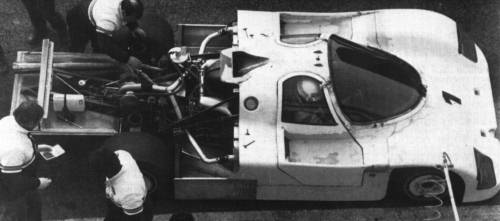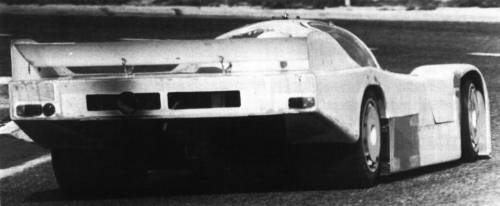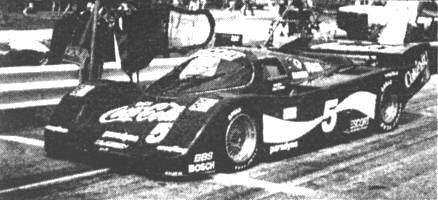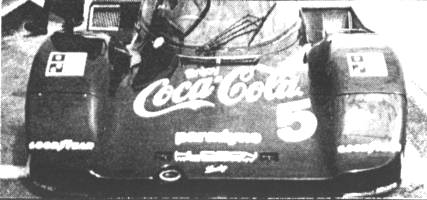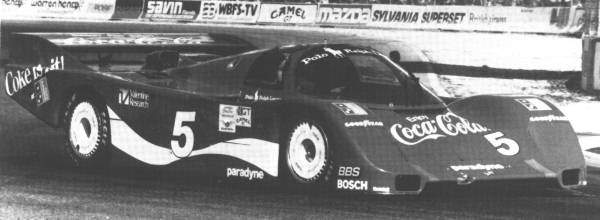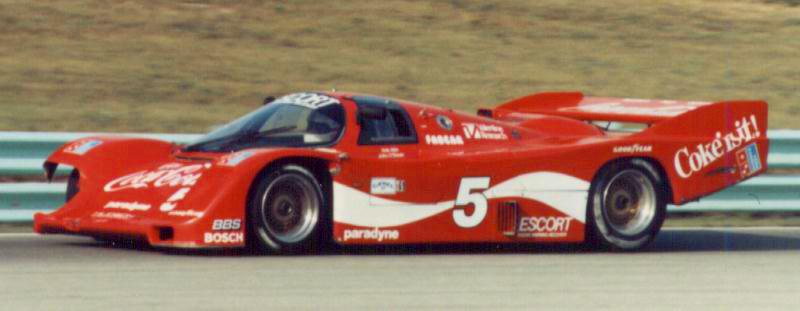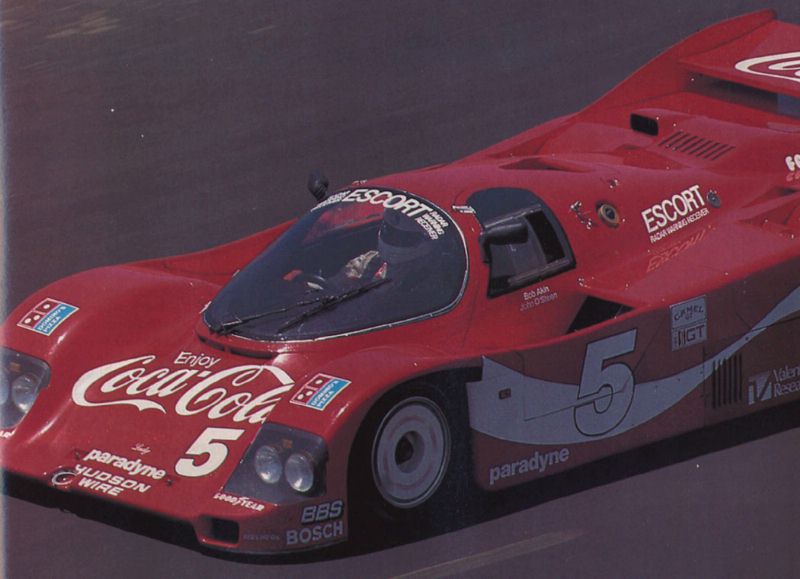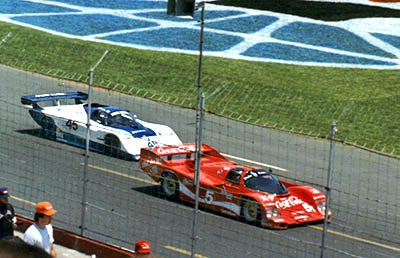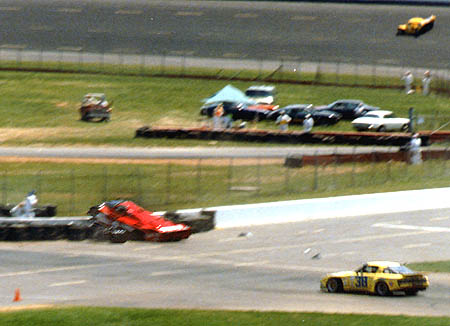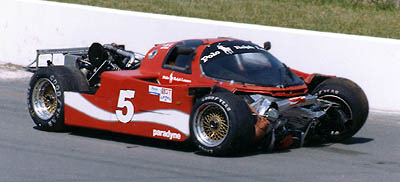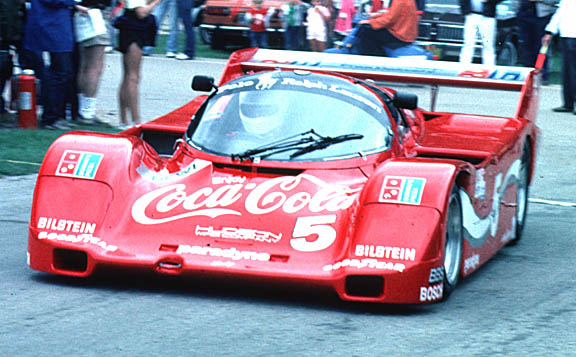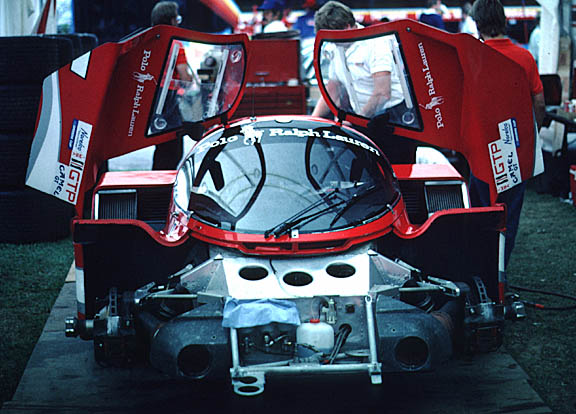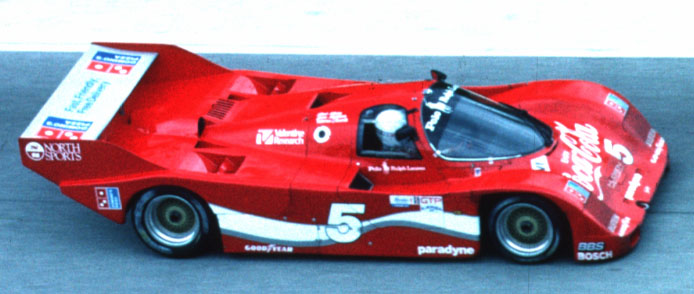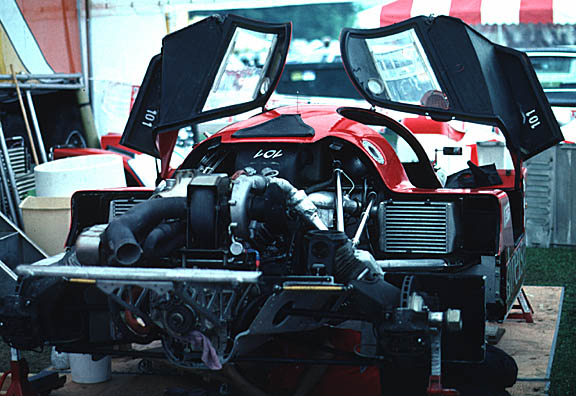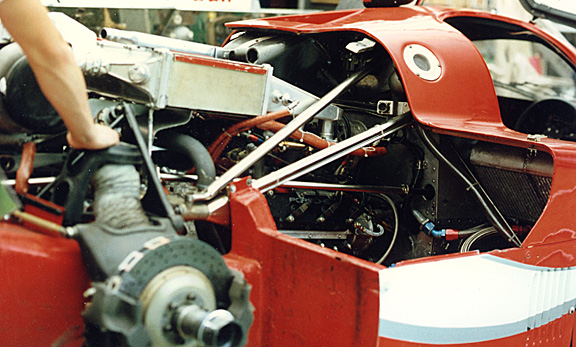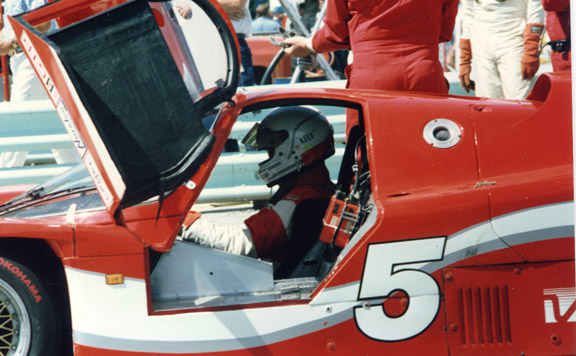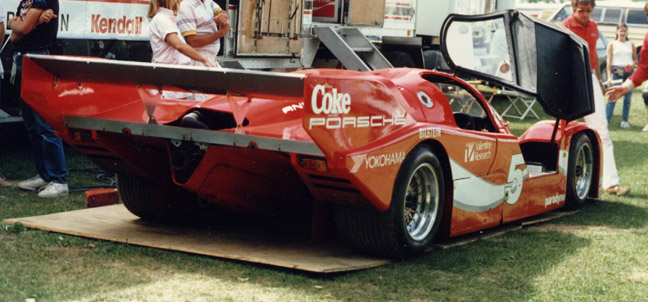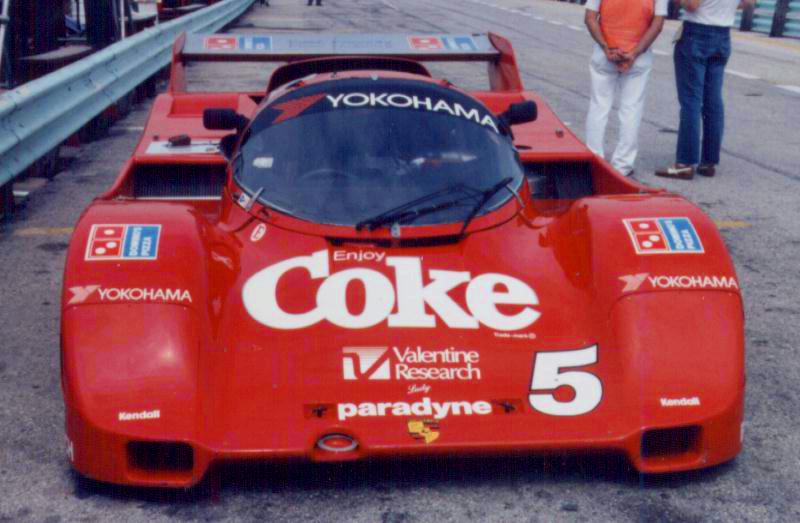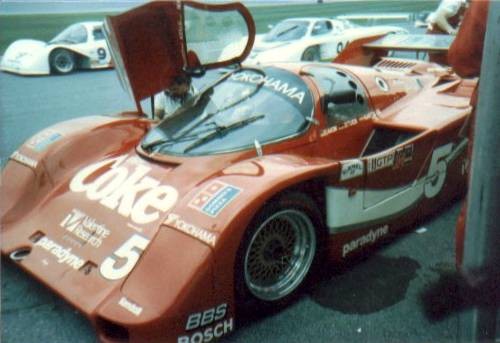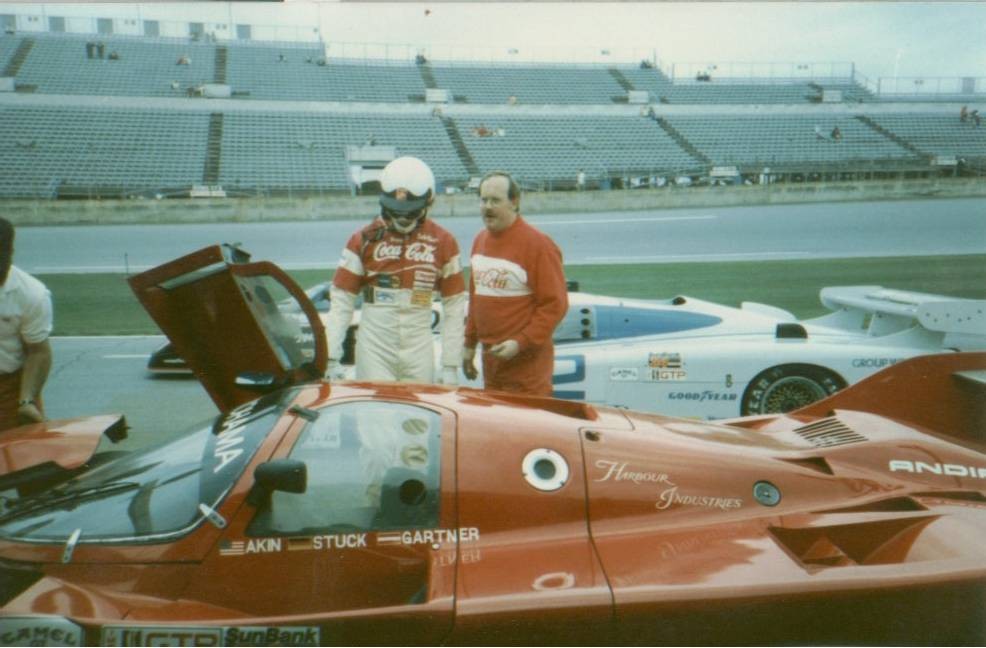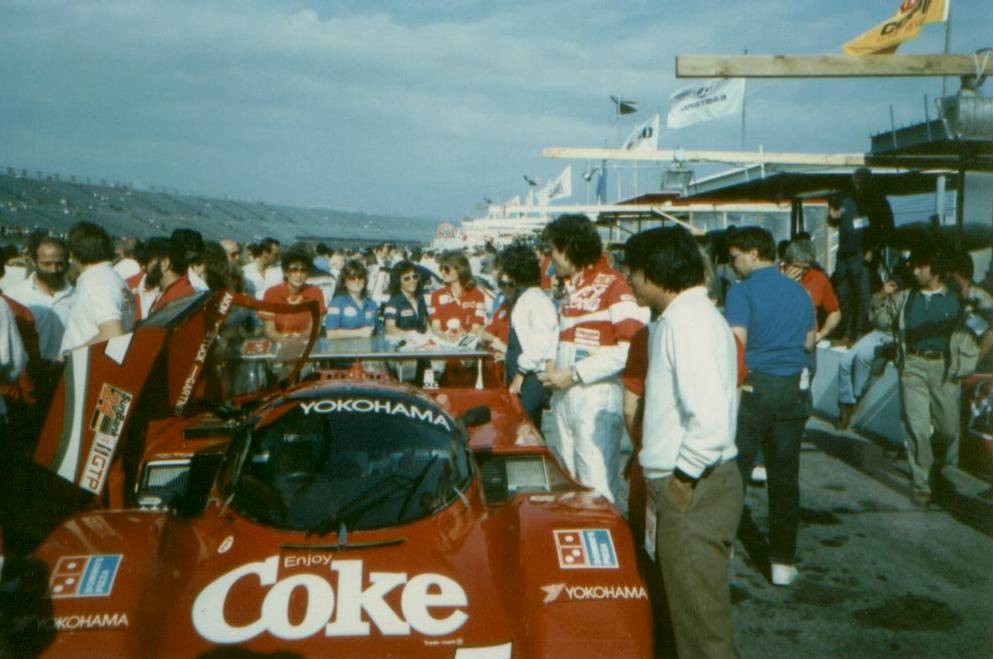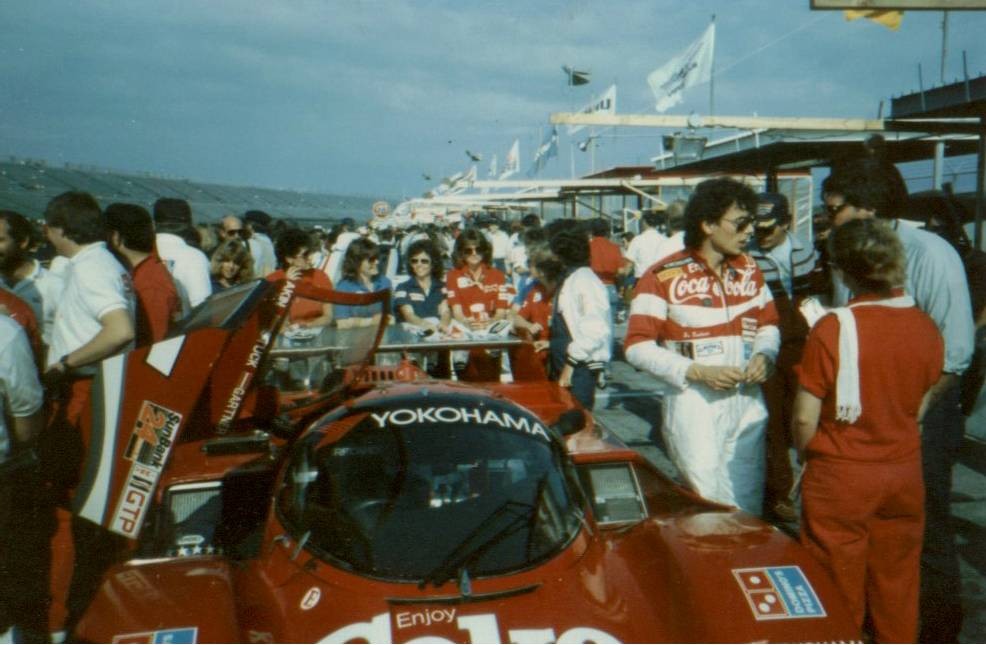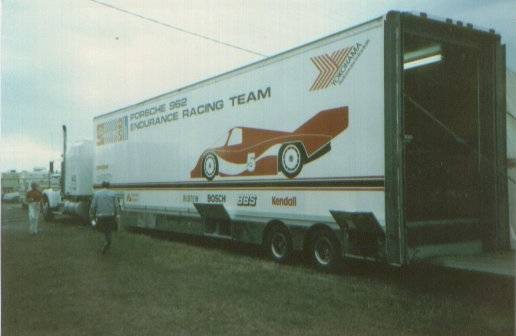Coca Cola IMSA Porsche 962

Photo by Mike Klessig
This project was initiated when I received a Fred Cady Design decal sheet (number 81) from my e-mail pal and fellow sports car lover Jim McCall. Thanks again for tracking down that sheet, Jim! Of all IMSA Porsche 962's, I always liked the bright red and white Coca Cola sponsored car best. The red painted headlight covers accentuate the nice lines of the car. The decal sheet also allows one to build the Porsche 935 K3 raced by Bob Akin; I've collected some pictures of Bob Akin's Porsche 935's too. Over time this web page grew so large that I decided to divide it in three parts.
This first page shows details of the 1:1 scale Porsche 962, both the factory prototype and the two chassis that Bob Akin owned.
|
The Porsche 962 prototype
The 962 was developed specifically for IMSA to comply with the rule that the driver's feet should be behind the front axle. The engine too was changed, now with only one turbo and air cooled cylinder heads. The 962 was later also used in Group-C, but then designated 962C, with a 956 engine.
The following three pictures show some interesting details of the 962 prototype. They clearly show the IMSA specific tail, used in the 1984 and 1985 seasons. The middle picture shows how the underbody extends to the rear edge of the body, and the new and larger engine cooling air intake.
Bob Akin's 962
A short history of the car: chassis number 962.102 was bought in 1984 by Bob Akin and appears to have been a completely stock 962 (IMSA tail, turbo bump, BBS 16" wheels). It was not very successful in the first season, 6th being the best finish. It was also raced in the 1985 season, with very few changes as far as I can tell. Unfortunately it was destroyed in a crash at Charlotte.
Bob Akin bought a new chassis (chassis number 962.113) and built up a new car, incorporating many modifications that other teams had been using for some time. Most striking was the Group-C style short tail, and later a new turbo bump on the engine cover. This car therefore looked rather different than the original 962.102.
There are no instructions for Cady's sheet, but the catalog says it's for the car in the 1985 season. I decided to build it in its initial form, as raced in 1984 and early 1985. First three black and white pictures of the car in this trim. The first two are from the Cady catalog. The outer pictures clearly show the original IMSA tail fitted to the car.
Mike Klessig sent me the following picture, showing the car in 1984 at Elkhart Lake. It probably shows the car in its most original shape. It clearly shows the original IMSA tail, and the 'turbo bump' on the engine cover and air intake that all cars used initially. Also shown are the gold-spoked BBS wheel, both front and rear. In some other races they were fitted with aerodynamic covers that also provided extra brake cooling. Apparently Porsche provided unclear information about their effectiveness, causing confusion. The car has a red wing with Coca Cola lettering (the follow-up car had a silver wing). The inlet on the side (just in front of the ESCORT lettering) has been fitted with some extra sheet metal.
A fellow sports car modeler scanned the following magazine photo. It shows the car during the 1984 Charlotte 500 km race (20 May). Due to the unusual angle, the photo shows many interesting details, such as a good view of the turbo hump, and the deep left-hand door inlet. Interestingly it has transparent light covers, whereas it usually had red-painted ones.
The following three pictures were kindly sent to me by Tim Crete of the Fast Details sports car racing site. They show the car at its fatal race at Charlotte in 1985. The pictures are made and copyrighted by Tim Crete. The left picture shows the car shortly after the start being hotly pursued by the Conte March which was soon to be the cause of the Porsche's destruction. The middle picture shows the Porsche resting on the infield wall where it came to rest after being hit on the left side by the March. John Paul, Jr. had just taken over the Conte March from Bill Adam, and in his zeal to make up time he clipped the back of a Firebird and went for the ride across the grass, finally hitting the Porsche that was just starting a left turn. The right picture shows some of the damage to the Porsche. Especially this picture shows interesting details for modelers.
After the accident a new monocoque (962.113) was ordered from Porsche, and the car was rebuilt, probably using the mechanical parts of the original car 962.102. The following pictures shows the car as it appeared at the Road America race in August 1985. The pictures were shot and kindly supplied by Tom Hiett. The car shows some differences with the original car, such as a Group-C short tail, a silver shadow under the white stripe over the car's side, No 'Coca Cola' or 'Coke' on the sides, and a silver rear wing. Quite peculiar is that the right door inlet is shallow, this can be seen in the third picture.
The photo shown below used to be included in the Road America 1985 photo set. In 2006 Van Zannis, the current owner of Bob Akin's 962.113, spotted correctly that this was the Dyson Racing Budweiser-sponsored 962.101. If you look closely you can see the 'dweise' markings on the side. That also eliminates the theories previously listed to explain the '101' stencils on various parts of the car :-) Nevertheless, this Tom Hiett photo gives a good view of the engine bay in the original configuration, and it is therefore still shown here. It also shows a shallow right door inlet and a 'normal' deep left door inlet.
The same car was also raced in the 1986 season, with more changes. The turbo intercooler was placed over the engine (as clearly shown in the first picture), requiring a new 'turbo bump', of which the front end is visible in the second picture. Not visible is that the large 'Coca Cola' lettering on the nose is replaced by 'Coke'. The pictures were again shot and supplied by Tom Hiett.
Two more pictures by Mike Klessig, showing the car at the 1986 Elkhart Lake race. The car is fitted with a Group-C short tail and brake cooling discs on all wheels.
Lastly, a great set of photos contributed by Robert Immler. The 'Sunbank 24' sticker on the open door strongly suggests the photos were take at the Daytona race that took place on 2 February 1986.
Mark Windecker's IMSA photo archive also contains some nice photos of Akin's Porsche 962.
The IMSA 962 engine bay
I still don't fully understand the various turbo+intercooler layouts used in the IMSA models. As far as I can tell, there were 3 layouts:
one that is similar to that shown in the top view of the proto, a single turbo, with a short pipe running forward and then splitting in two very long pipes leading to intercoolers in the same position as the original 956 (i.e. fed from the door inlets). The 'turbo bump' was moderately sized and only had cooling slots, plus a snorkel type air inlet.
a cutaway drawing (the only of an IMSA 962 that I know) shows another version, with a large diameter duct leading forward from the turbo to somewhere behind the monocoque. What happens next is a mystery to me. I don't think I've ever seen a photo of a real car showing this layout, and I doubt it really existed
the final layout has a intercooler between the turbo and inlet manifold, and no intercoolers behind the door inlet. At least two sizes of intercoolers were used, one fairly small and one quite large. The 'turbo bump' was much larger, and now looks like a very large air scoop
The Akin 962 had layout 1 initially, both the original chassis 962.102 (see the photo of the wrecked car and you will just see the pipe splitting up in two), and the replacement chassis 962.113 (see Tom Hiett's 1985 second Road Atlanta photo). Akin was quite late in updating his car to the third layout.
Sadly, Bob Akin was severely wounded in a heavy accident while testing a Nissan GTP in preparation for a historic race. He died four days later, 29 April 2002, in an Atlanta hospital.
Return to models page


